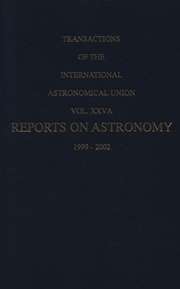No CrossRef data available.
Article contents
Commission 21: Light of the Night Sky: (Lumiere du Ciel Nocturne)
Published online by Cambridge University Press: 25 April 2016
Extract
It has been known that non spherical silicate particles of a size comparable to the wavelength of light, and aggregates of such particles, produce negative polarization in the backscattering region (e.g. Xing & Hanner 1997, Yanamandra-Fisher & Hanner, 1999). It has now been shown that large aggregates of small absorbing particles of fractal dimension about 2 produce a slightly negative polarization at small phase angles (Levasseur-Regourd et al., 1997). The phase-curves strongly differ from those of Mie spheroidal particles. They are likely to be due to scattering by irregular dust particles and/or fluffy aggregates of numerous submicronic absorbing particles (Levasseur-Regourd et al., 1997; Lumme et al., 1997).
- Type
- Divisions and their Commissions
- Information
- Transactions of the International Astronomical Union , Volume 24 , Issue 1: Reports on Astronomy , 2000 , pp. 152 - 155
- Copyright
- Copyright © Astronomical Society of Pacific 2000




